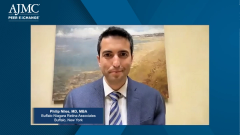
Considerations for Use of Bevacizumab-vikg in Wet AMD
Nicholas G. Anderson, MD, leads a discussion on how the first ophthalmic formulation of bevacizumab may impact the wet AMD treatment paradigm.
Episodes in this series

Jim Kenney, RPh, MBA: We don’t always get extrapolation of all the indications. I think the original biosimilar bevacizumab didn’t have evidence for off-label use, obviously, because there is no approved bevacizumab. But we do have an ophthalmic formulation of bevacizumab in development for wet AMD [age-related macular degeneration]. Maybe we can get a comment from one of our experts on that one, but how would a true FDA-approved alternative bevacizumab impact the treatment paradigm?
Nicholas G. Anderson, MD: Again, I think it’s going to be pretty interesting to see. It’ll be a bit of a wait-and-see, certainly. The lack of FDA approval for Avastin [bevacizumab] is obviously not a deal breaker. It’s one of the top 3 most utilized drugs for both diabetic macular edema and wet macular degeneration. I think retina specialists have long since gotten over the fact that we don’t have an FDA label indication for Avastin [bevacizumab]. But from a medical standpoint for me, I think having a noncompounded Avastin [bevacizumab] is perhaps the important point here.
There’s a really interesting study done by Nicolas A. Yannuzzi, MD, in 2015, where he took Avastin [bevacizumab], just commercially purchased from 11 different compounding pharmacies across the country, the same purchasing process that all of our practices use. He had this very wide mix of compounding pharmacies from across the country. Of course, all these pharmacies were accredited. He actually found that 80% of the Avastin [bevacizumab] syringes that he purchased had a decreased concentration of active ingredients as compared to the manufactured Avastin [bevacizumab] that we all get from a vial.
So it’s not really the FDA-approval part that worries me, it’s the compounding. If we can overcome the compounding issue, that theoretically should be an important safety consideration. Compounding theoretically decreases the efficacy of the drug. It certainly introduces the potential for microbial contamination. We’ve all seen these outbreaks of endophthalmitis at the VA [Veterans Affairs] hospital and other academic institutions that led to the FDA recall. That’s what we’re all terrified of, endophthalmitis, and rightly so. If we have a noncompounded Avastin [bevacizumab], I think that’s going to be a valuable addition. I think for this specific product though, there are going to be some very significant questions.
There was a clinical trial that is potentially leading to the FDA approval, but the clinical trial design was frankly quite baffling. Our practice does quite a few clinical trials, and we did not participate in this trial, and for good reasons. No. 1, it was only a 12-month trial. Most of the FDA approval trials, the pivotal trials, are at least 24 months, because again, these are long-term treatments. This was only a 12-month trial, it’s pretty short follow-up. Relatively inexplicably to me as a practitioner, the patients were randomized to receive over those 12 months, 12 doses of the new bevacizumab, but the comparator group, rather than what we would expect to be 12 injections of ranibizumab, they only administered 5 doses of ranibizumab. It’s completely comparing apples to oranges. And so, yes, the manufacturer did, of course, get the trial results that they wanted. You never want to design a trial that is going to fail. You always want to design for success. But they took that to the extreme here. And so, I don’t think there are any practicing retina physicians who are going to accept the trial data at face value when you’re comparing 12 doses to 5 doses. It’s just completely apples to oranges.
Jim Kenney, RPh, MBA: That’s very interesting feedback. I think the other interesting thing relates to compounded products. Typically, when you have a product that’s compounded in the market, and then a drug actually gets an approval, an FDA label and approval, if you continue to compound the drug, that can be determined as a misbranding situation by the FDA. Then the compounder has to stop compounding the product. Now occasionally, you can have situations where the FDA will allow that. We saw that with the drug Makena [hydroxyprogesterone caproate], which was a 17P progestin product, where we had a branded company launch, but the FDA allowed compounding to continue because the cost of that brand was significantly higher than the cost of the compounded version. But that’s a very usual situation. I think it’ll be interesting to see if this product does get an approval, if the compounds are forced to cease and desist in order to avoid any type of misbranding situation with the FDA.
Nicholas G. Anderson, MD: Right, it’ll be very interesting.
Philip Niles, MD, MBA: That’s a great example, especially as I think most retina physicians are comfortable with whatever they’re using currently. I happen to use a lot of Avastin [bevacizumab]. About 60% of my injections, I’d say, are bevacizumab, or Avastin, from a compounding pharmacy that I feel quite comfortable using, I’ve been using them for years. I’m not certain how motivated people would be to switch from what they’re used to using, especially given the variability in efficacy. I’m used to the Avastin [bevacizumab]from my current pharmacy, and to change it, it might come with some certain pros of changing, but it might also come with an adoption period that might be less desirable. It’s really unpredictable how things are going to go this year. I feel like things aren’t usually this quickly changing, but I feel like 2022 and 2023 are going to be really big years for retina, and specifically socioeconomic issues related to retina care.
Nicholas G. Anderson, MD: Right. We’ve gone for 15 years with just a handful of medications, to in 1 year the fire hose is opening up for us.
Jim Kenney, RPh, MBA: You can rest assured that the health plans have their eyes on ranibizumab and the price, depending on where that’s going to come in, because that may enter the picture as a new step in the process that doesn’t exist. It could create some challenges obviously for the treatment of patients. It’ll be interesting to see.
Transcript Edited for Clarity
Newsletter
Stay ahead of policy, cost, and value—subscribe to AJMC for expert insights at the intersection of clinical care and health economics.






































